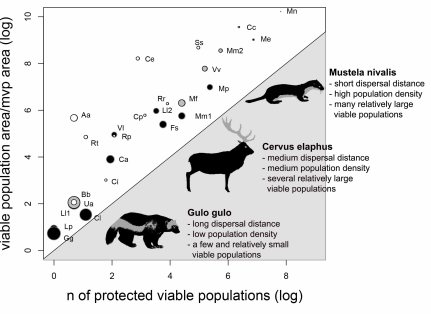SANTINI L., DI MARCO M., BOITANI L., MAIORANO L., RONDININI C.
Diversity & Distribution DOI: 10.1111/ddi.12198
 Gap analysis measures the percentage of protected species distribution and generally compares it to a representation target (i.e. minimum area to be protected). The results are used to identify species that need further protection, providing a quantitative baseline to address a possible expansion of a given protected area (PA) systems. However, the achievement of the same representation target may have different implications in terms of species persistence depending on population spatial structure and conservation needs. The aim was to investigate to what extent and why gap analysis may provide inequitable assessments of species protection.
Gap analysis measures the percentage of protected species distribution and generally compares it to a representation target (i.e. minimum area to be protected). The results are used to identify species that need further protection, providing a quantitative baseline to address a possible expansion of a given protected area (PA) systems. However, the achievement of the same representation target may have different implications in terms of species persistence depending on population spatial structure and conservation needs. The aim was to investigate to what extent and why gap analysis may provide inequitable assessments of species protection.
We performed three gap analyses on 27 European species of carnivores and ungulates, measuring the level of protection according to three different types of distribution data: geographical ranges, habitat suitability models and habitat suitability models that incorporate the potential spatial structuring in populations within PAs.
The estimated degree of species protection depends on the distribution proxy and the target adopted. When the analyses are based on areas able to support viable populations (irrespective of how these areas are quantified), the perceived relative protection of different species changes considerably. The ability of different species to persist in PA systems mostly depends on their population density and dispersal abilities, as well as the interaction between these two features, which eventually determines the number and relative size of the populations.
The achievement of the same representation target for different species may imply protecting different numbers of individuals in populations having different spatial structures and may consequently lead to different probabilities of persistence across species. If species spatial structuring is disregarded, gap analysis may thus lead to inequitable assessments of PA coverage.

You must be logged in to post a comment.